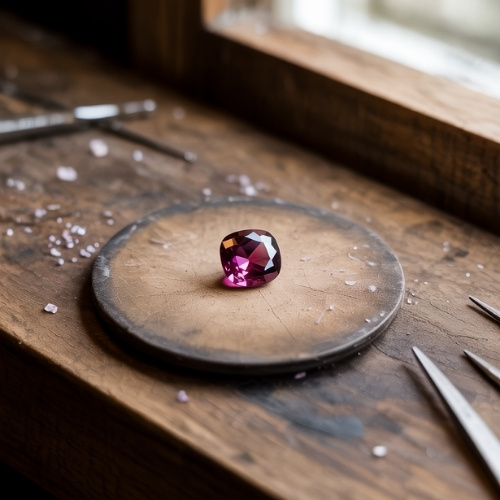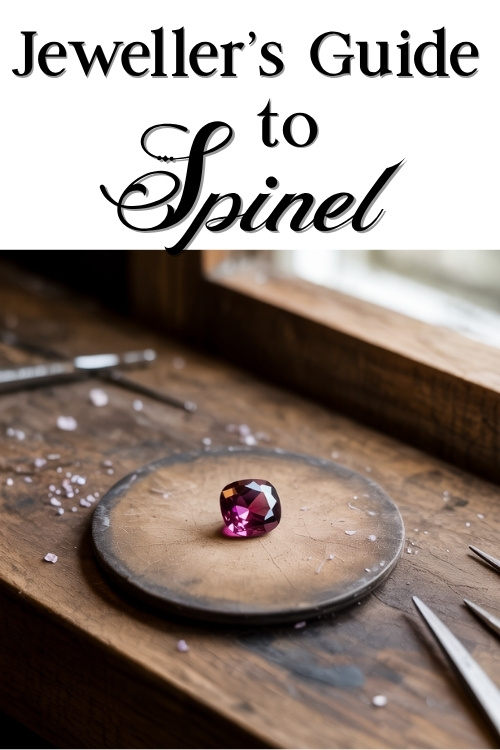There’s something quietly captivating about spinel, a gem that glows in shades of red, pink, lavender, blue, and more. Once mistaken for ruby, spinel is finally stepping into the spotlight in its own right. Durable, brilliant, and full of colour, it’s a gemstone with both history and heart, and one that jewellery designers would do well to explore.
Basic Identification Information
Name & Synonyms
Spinel
Species
Spinel
Colour Range
Red, pink, orange, purple, violet, blue, grey, black, and occasionally yellow or greenish tones.
Some rare spinels display colour change.
Refractive Index
1.710 – 1.735
Birefringence
None (singly refractive)
Optical Sign
None (singly refractive)
Pleochroism
None
Specific Gravity
3.57 – 3.70
Fluorescence
Variable by colour.
Red, orange, and pink stones: red or orange glow
Purple stones: red glow
Pale blue and violet: green glow
Near-colourless and light green: red or reddish-orange glow, or sometimes inert
Other colours: usually inert
Lustre
Vitreous (glass-like)
Clarity
Type II
Many spinels have visible inclusions, though eye-clean examples are possible.
Gems Often Mistaken For
Ruby, Sapphire, Garnet, Tourmaline
Mohs Hardness
8
Wearability
Excellent
Birthstone
August (modern addition alongside peridot)
Spotting Synthetic (Lab-Grown) Spinel
Synthetic spinels are commonly used in inexpensive birthstone jewellery and can be easy to mistake for natural gems at a glance. They’re often strikingly clean with a vivid hues, sometimes with colours not typically seen in nature.
Under magnification, synthetic spinel may show curved striae or gas bubbles are both strong indicators of a man-made origin.
Common Treatments
Spinel is one of the rare gemstones that usually appears untreated on the market, a powerful selling point for jewellers. Its natural colour and brilliance often need no enhancement.
Durability & Setting Considerations
With a Mohs hardness of 8 and no cleavage, spinel is both tough and practical, making it great for rings, pendants, earrings, and bracelets, including engagement rings and other daily-wear designs.
It resists chipping and cracking better than many other coloured gems, giving jewellers more freedom in setting. However, care is still needed if the stone has visible surface-reaching inclusions, which may weaken structural integrity.
Care Instructions
Cleaning
Warm soapy water and a soft brush are the safest choices. Spinel can often tolerate ultrasonic cleaning if it’s free from visible inclusions, but steam cleaning should be avoided to prevent thermal shock.
Storage
It’s best practice to store gems separately to protect them from scratching or chipping each other, or from being scratched by harder stones like sapphire or diamond.
Daily Wear
Spinel’s hardness and toughness make it one of the most fuss-free coloured gems for regular wear. It performs well in rings, even on active hands, but do remember it’s not indestructible.
Market & Ethical Notes
Spinel has long been an underappreciated gem in mainstream circles, offering excellent value for jewellers seeking colour, clarity, and durability without the ruby or sapphire price tag.
Major sources include Sri Lanka, Myanmar (notably the Mogok region), Vietnam, Tanzania, and Tajikistan. The deep red spinels from Myanmar (formally Burma) are especially revered, often compared to fine rubies in appearance.
Most spinel is mined via small-scale methods. Ethical sourcing remains essential, look for suppliers committed to transparency, fair labour practices, and responsible mining.
Symbolic & Spiritual Meanings
Spinel is often seen as a stone of revitalisation and endurance. It’s believed to help restore energy, boost inner strength, and bring clarity during stressful or challenging times.
Red spinel is associated with passion and vitality, while lavender and violet varieties are thought to encourage peace and spiritual awareness. Across all colours, spinel is commonly used for protection, helping to shield against negativity.
This quiet strength makes spinel a popular choice in crystal healing and spiritual jewellery.
🔗 Dive deeper into Spinel’s Symbolic & Spiritual Meanings
Etymology
The name spinel likely comes from the Latin spina, meaning “thorn”, a nod to the sharp, pointed crystal formations in which the gem sometimes occurs.
🔗Curious about how spinel was viewed in ancient cultures? Explore its fascinating myths and legends (coming soon)
Notable Varieties & Trade Names
While spinel doesn’t have as many trade names as some other multi-coloured gemstones, here are a few terms you might come across:
Cobalt spinel – Bright, electric blue stones coloured by cobalt; very rare and valuable.
Flame spinel – A historical name often used for vivid red stones, most commonly seen in relation to vintage jewellery.
Mahenge spinel – Neon pink to red gems from Tanzania’s Mahenge region, known for their exceptional brightness.
Lavender spinel – Soft violet stones with calming overtones, often pastel in colour.
📌 Save this jeweller’s guide to spinel for quick reference next time you’re working with this stunning gem.


